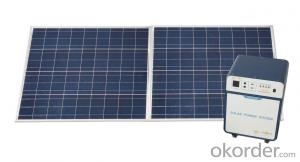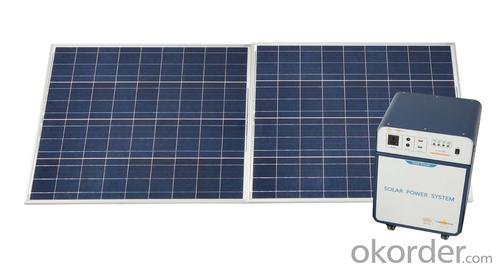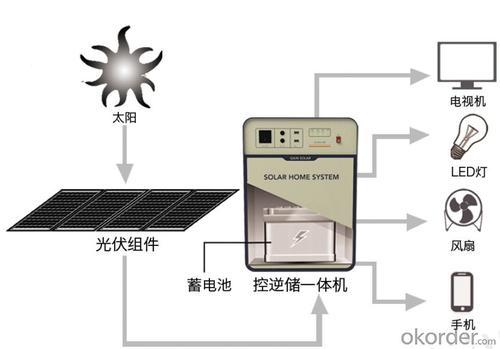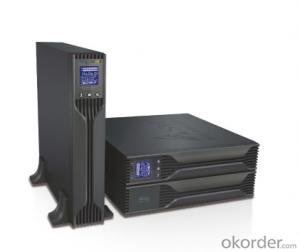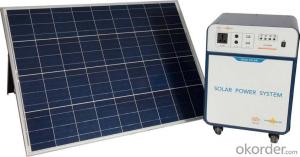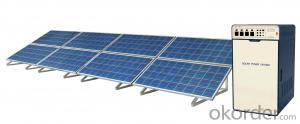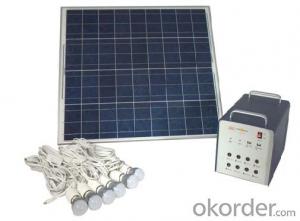Greenlogic Solar Energy Systems - Off-Grid Solar Power System JS-SPS-300
- Loading Port:
- Tianjin
- Payment Terms:
- TT or LC
- Min Order Qty:
- 10 set
- Supply Capability:
- 10000 set/month
OKorder Service Pledge
OKorder Financial Service
You Might Also Like
General Introduction
Solar power system provides alternating current and direct current, which is produced by the modules transforming solar power into power, to home lighting, household appliance and other DC appliance, such as cell phone and laptop.
Solar power system is widely used in area lack of power, for example house power supplying, monitoring, communication base, fire prevention in forest area, pasture and meadow, aquaculture etc.
We are dedicated to provide high quality off-grid PV products and systems to customers and has received a series of certificate, including ISO9001, TUV, UL, CE, CQC and RoHS.
Off-grid Solar Power System
High efficent PV module can produce more power.
Sine wave output is suitable for all kinds of load. Varieties of DC output, let it more convenient for users.
The multifunction design make it easy to operation and maintenance.
Off-grid Solar Power System Parameters
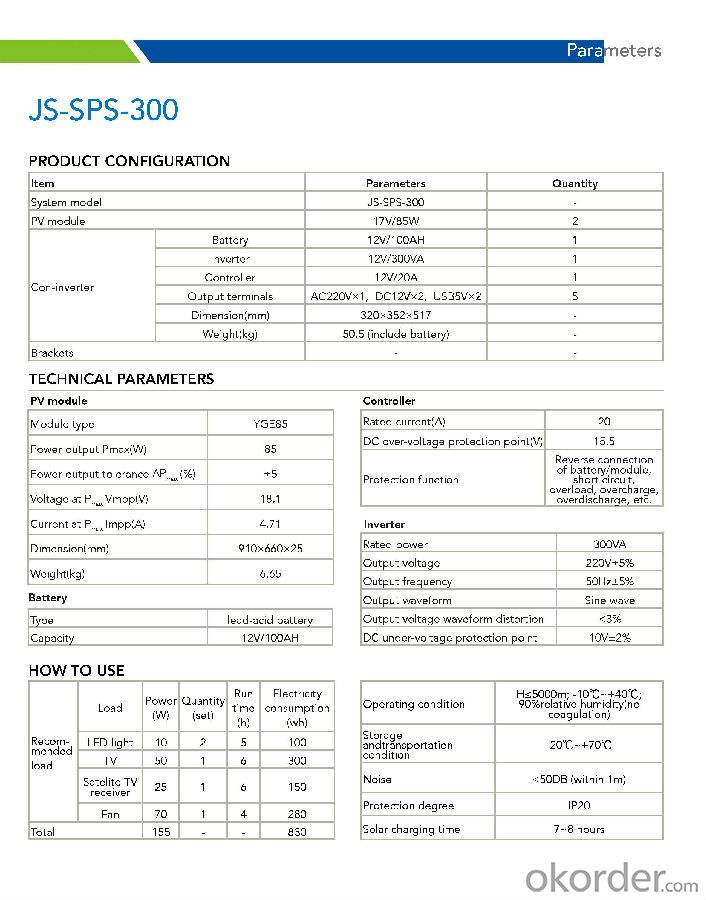
Off-grid Solar Power System Application
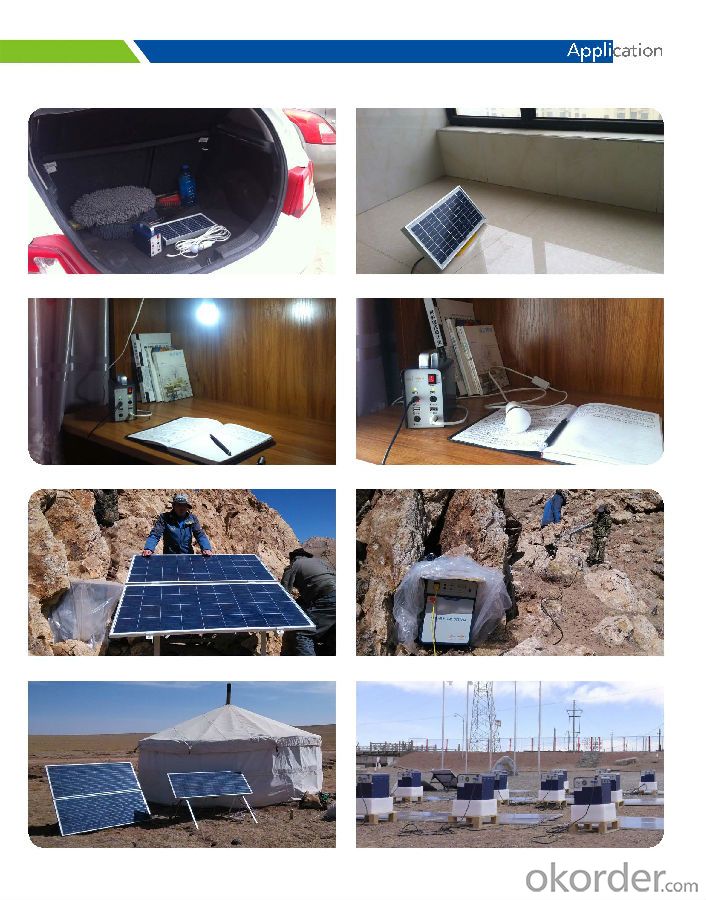
Our Factory
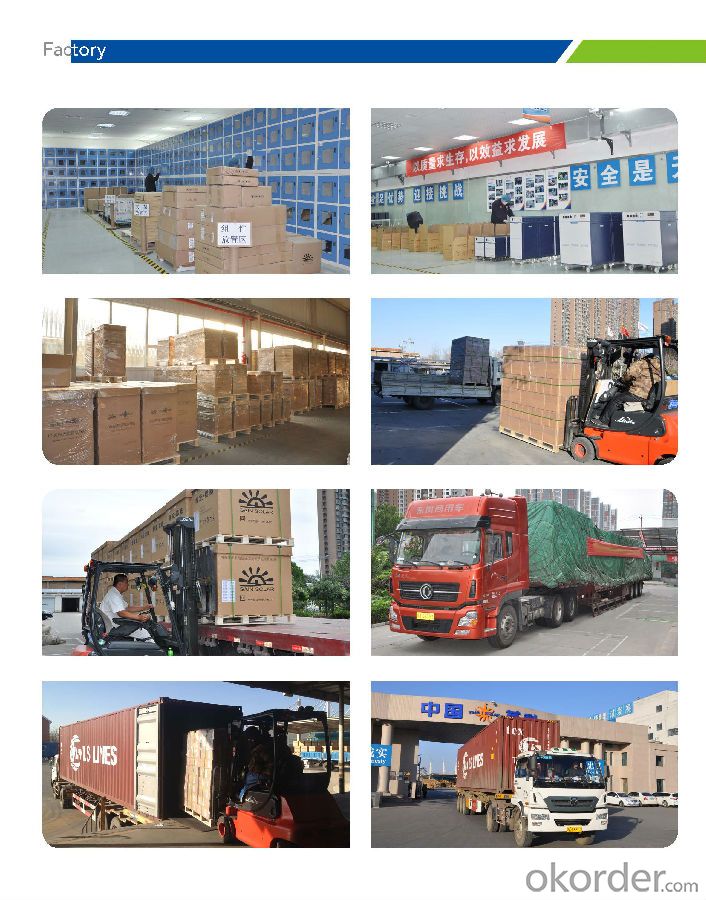
- Q: Can solar energy systems be used in mining operations?
- Yes, solar energy systems can be used in mining operations. Solar power can be harnessed to generate electricity for various mining activities, such as powering equipment, lighting, and ventilation systems. It offers a sustainable and cost-effective alternative to traditional fossil fuel-based energy sources, reducing both operational costs and environmental impact. Additionally, solar energy systems can be easily deployed in remote mining sites where grid electricity may be unavailable or expensive to access.
- Q: Can solar energy systems be used for powering shopping malls?
- Certainly, shopping malls can indeed utilize solar energy systems to power their operations. The sun's energy can be captured by installing solar panels on the rooftops or parking lots of shopping malls. This captured energy can then be converted into electricity, which can be used to power various functions within the mall, such as lighting, heating and cooling systems, escalators, elevators, and other electrical appliances. By embracing solar energy, shopping malls can greatly reduce their reliance on conventional energy sources and decrease their carbon emissions. Moreover, solar energy systems can contribute to long-term electricity cost savings for malls, as they produce clean and renewable energy. All in all, solar energy systems offer a feasible and sustainable solution for meeting the power needs of shopping malls.
- Q: Can solar energy systems be used for powering off-grid sustainable communities?
- Yes, solar energy systems can definitely be used for powering off-grid sustainable communities. Solar panels can generate electricity by converting sunlight into usable energy, providing a reliable and renewable source of power. These systems can be installed in remote areas where access to the conventional power grid is limited or non-existent, allowing off-grid communities to become self-sufficient and sustainable. Solar energy is clean, emission-free, and requires minimal maintenance, making it an ideal solution for powering off-grid communities and promoting sustainable development.
- Q: Can solar energy systems be used for powering electric vehicle charging infrastructure?
- Yes, solar energy systems can be used to power electric vehicle charging infrastructure. Solar panels can be installed to generate electricity from the sun, which can then be used to charge electric vehicles. This renewable energy source is a sustainable and environmentally-friendly option for powering electric vehicle charging stations.
- Q: Can solar energy systems be used in powering manufacturing plants?
- Certainly, manufacturing plants can utilize solar energy systems to power their operations. In fact, numerous manufacturing plants worldwide are already implementing solar energy as a sustainable and environmentally friendly power source. To harness the power of the sun, solar panels can be installed either on the rooftops or in open areas near the manufacturing facility, converting sunlight into electricity. Solar energy systems bring several benefits to manufacturing plants. Firstly, they can significantly decrease electricity expenses by utilizing the energy generated by solar panels to operate the facility, thereby reducing reliance on conventional fossil fuel-based energy sources. This can result in substantial long-term savings. Moreover, solar energy systems require relatively low maintenance and have a long lifespan, making them a cost-effective investment for manufacturing plants. With proper care and maintenance, solar panels can last for 25 to 30 years, or even longer. This means that manufacturers can enjoy reduced electricity costs for an extended period. Additionally, solar energy is a clean and renewable power source. By adopting solar energy systems, manufacturing plants can make a significant contribution to reducing their carbon footprint and promoting environmental sustainability. This aligns with the global trend of reducing greenhouse gas emissions and transitioning towards clean energy sources. It is important to consider various factors, such as available space for solar panel installation, energy requirements of the plant, and local climate when determining the feasibility of solar energy systems in manufacturing plants. Nevertheless, advancements in solar technology and decreasing costs have made solar energy an increasingly viable option for many manufacturing plants. To sum up, solar energy systems can certainly power manufacturing plants and offer numerous advantages, including cost savings, environmental sustainability, and long-term reliability. As the demand for clean energy continues to rise, solar power is becoming an increasingly appealing choice for manufacturers seeking to reduce their carbon footprint and embrace renewable energy sources.
- Q: Can a solar energy system be used to power outdoor lighting?
- Certainly, outdoor lighting can unquestionably be powered by a solar energy system. As a matter of fact, the popularity of solar-powered outdoor lighting systems is on the rise due to their myriad of advantages. Sunlight is captured by solar panels that are either installed on rooftops or positioned in open areas, subsequently converting it into electricity which can then be stored in batteries for utilization during the night or on days when the weather is overcast. This stored energy can be employed to operate outdoor lighting fixtures like streetlights, garden lights, pathway lights, and even security lights. In addition to being cost-effective and environmentally friendly, solar-powered outdoor lighting systems necessitate no electrical wiring, making them simple to install and maintain. Furthermore, they offer the benefit of independence from the grid, guaranteeing uninterrupted illumination even during power outages. All in all, solar energy systems are an exceptionally efficient and sustainable solution for powering outdoor lighting.
- Q: What are the disadvantages of using solar energy?
- One disadvantage of using solar energy is its intermittent nature, as it is dependent on sunlight availability. Factors such as cloudy weather or nighttime can limit its energy generation. Additionally, solar panels and the necessary equipment can be expensive to install, which may deter some individuals or businesses from adopting solar energy.
- Q: Can solar energy systems be used for powering electric vehicle wireless charging systems?
- Indeed, electric vehicle wireless charging systems can be powered by solar energy systems. These solar energy systems, such as solar panels, have the capability to capture sunlight and convert it into electricity. This electricity can then be utilized to power a wide range of devices and systems, including electric vehicle wireless charging systems. The process of utilizing solar panels to charge electric vehicles wirelessly involves the installation of these panels on either a building or a dedicated solar carport. Once the solar panels are in place, they are able to gather sunlight, which is subsequently transformed into electricity. This electricity can be stored in batteries or directly supplied to the charging system. The utilization of solar-powered wireless charging systems presents numerous advantages. Firstly, it provides a sustainable and renewable energy source, reducing the reliance on fossil fuels. Consequently, this contributes to the creation of a cleaner and more environmentally friendly atmosphere, as solar energy is a clean and emission-free power source. Secondly, solar-powered charging systems can be installed in remote areas where access to the power grid may be limited. This allows for the convenient charging of electric vehicles in locations that lack traditional infrastructure. Furthermore, solar energy systems have the potential to decrease the overall energy expenses associated with charging electric vehicles. By harnessing the power of the sun, electric vehicle owners can benefit from lower operational costs and even have the opportunity to earn money by selling any excess energy back to the grid. In conclusion, it is evident that solar energy systems can undoubtedly be utilized to power electric vehicle wireless charging systems. These systems offer a sustainable, renewable, and economically viable solution for charging electric vehicles, all while reducing the environmental impact and promoting energy independence.
- Q: How much space do I need for a solar energy system?
- The space required for a solar energy system depends on various factors such as the size of the system, the amount of energy needed, and the efficiency of the solar panels. In general, for a residential solar energy system, you would need a roof space of about 100-400 square feet per kilowatt (kW) of solar panels. However, there are alternative options like ground-mounted systems or solar canopies that can be used if roof space is limited. It is recommended to consult with a solar energy professional who can assess your specific energy needs and available space to determine the appropriate size and configuration of the system.
- Q: What is the impact of solar energy systems on air quality?
- Solar energy systems have a positive impact on air quality. Unlike traditional sources of energy such as coal or natural gas, solar energy does not produce harmful emissions or pollutants during its operation. This means that solar power generation does not contribute to the release of greenhouse gases, particulate matter, sulfur dioxide, nitrogen oxide, or any other air pollutants associated with fossil fuel combustion. By using solar energy systems, we can significantly reduce our reliance on fossil fuels and, consequently, decrease air pollution levels. This has numerous benefits for both human health and the environment. Improved air quality can lead to a decrease in respiratory and cardiovascular diseases, as well as a reduction in respiratory symptoms and allergies. Additionally, solar energy systems contribute to the overall reduction in smog, acid rain, and global warming potential. Furthermore, the installation and use of solar energy systems do not produce noise pollution, another significant benefit compared to traditional energy sources. This reduction in noise pollution has positive impacts on the well-being and overall quality of life for individuals residing near solar installations. Overall, the adoption of solar energy systems is a crucial step towards improving air quality and mitigating the negative impacts of climate change. By harnessing the power of the sun, we can significantly reduce air pollution, promote cleaner and healthier environments, and create a more sustainable future for generations to come.
Send your message to us
Greenlogic Solar Energy Systems - Off-Grid Solar Power System JS-SPS-300
- Loading Port:
- Tianjin
- Payment Terms:
- TT or LC
- Min Order Qty:
- 10 set
- Supply Capability:
- 10000 set/month
OKorder Service Pledge
OKorder Financial Service
Similar products
Hot products
Hot Searches
Related keywords
